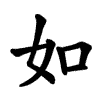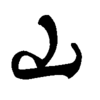Definify.com
Definition 2025
鬼
鬼
| ||||||
|---|---|---|---|---|---|---|
Translingual
| Stroke order | |||
|---|---|---|---|

| |||
| Stroke order (cursive) | |||
|---|---|---|---|

| |||
Han character
鬼 (radical 194 鬼+0, 10 strokes, cangjie input 竹山戈 (HUI) or 竹戈 (HI), four-corner 26213)
- Kangxi radical #194, ⿁ (“ghost”).
Derived characters
- Index:Chinese_radical/鬼
References
- KangXi: page 1460, character 30
- Dai Kanwa Jiten: character 45758
- Dae Jaweon: page 1993, character 19
- Hanyu Da Zidian: volume 7, page 4427, character 1
- Unihan data for U+9B3C
Chinese
|
simp. and trad. |
鬼 | |
|---|---|---|
Glyph oriign
| Historical forms of the character 鬼
| |||
|---|---|---|---|
| Oracle bone script | Bronze inscriptions | Large seal script | Small seal script |
 |
 |
 |
 |
| Characters in the same phonetic series (鬼) (Zhengzhang, 2003) | |
|---|---|
| Old Chinese | |
| 謉 | *tkuːlʔ, *krul |
| 瑰 | *kuːl, *ɡuːl |
| 傀 | *kuːl, *kʰuːlʔ |
| 藱 | *kuːl |
| 魁 | *kʰuːl |
| 磈 | *kʰuːlʔ, *qulʔ |
| 塊 | *kʰuːls, *kʰruːds |
| 嵬 | *ŋɡuːl, *ŋɡuːlʔ |
| 隗 | *ŋɡuːlʔ |
| 槐 | *ɡuːl, *ɡruːl |
| 瘣 | *ɡuːlʔ |
| 廆 | *ɡuːlʔ |
| 溾 | *ɡuːlʔ, *qruːl |
| 螝 | *ɡuːls, *krul |
| 褢 | *ɡruːl |
| 騩 | *krul, *kruls, *kul |
| 愧 | *kruls |
| 媿 | *kruls |
| 聭 | *kruls |
| 餽 | *ɡruls |
| 鬼 | *kulʔ |
| 魏 | *ŋɡuls |
| 巍 | *ŋul |
| 犩 | *ŋul, *ŋuls |
Pictogram (象形) – a man or figure with an ugly face and tail.
Compare 異 (“different, strange”), where the 田 also derives from a face.
It may not be clear from the character, but the lower right “dot” is a small 厶; it is a residual tail – compare 离.
Graphically, modern form is 甶 + 儿 + 厶.
Etymology
Unknown. May be related to 威 (OC *qul, “to overawe, to terrorise”) with k-nominalisation and endoactive tone B, lit. "the thing which is doing the overawing", or related to 歸 (OC *klul, “to return”). See also 詭 (OC *krolʔ, “to deceive; peculiar”).
Pronunciation
- Mandarin
- Cantonese (Jyutping): gwai2
- Hakka (Sixian, PFS): kúi
- Min Dong (BUC): gūi
- Min Nan (POJ): kúi
- Wu (Wiktionary): jy (T2); kue (T2)
- Mandarin
- (Standard Chinese, Beijing)+
- Pinyin:
- Zhuyin: ㄍㄨㄟˇ
- Wade-Giles: kuei3
- Gwoyeu Romatzyh: goei
- IPA (key): /ku̯eɪ̯²¹⁴/
- (Standard Chinese, Beijing)+
- Cantonese
- (Standard Cantonese, Guangzhou)+
- Jyutping: gwai2
- Yale: gwái
- Cantonese Pinyin: gwai2
- IPA (key): /kʷɐi̯³⁵/
- (Standard Cantonese, Guangzhou)+
- Hakka
- (Sixian, incl. Miaoli and Meinong)
- Pha̍k-fa-sṳ: kúi
- Hakka Romanization System: gui`
- Hagfa Pinyim: gui3
- IPA: /ku̯i³¹/
- (Sixian, incl. Miaoli and Meinong)
- Min Dong
- (Fuzhou)
- Bàng-uâ-cê: gūi
- IPA (key): /kui³³/
- (Fuzhou)
- Min Nan
- (Hokkien)
- Pe̍h-ōe-jī: kúi
- Tâi-lô: kuí
- Phofsit Daibuun: kuie
- IPA (Xiamen): /kui⁵³/
- IPA (Quanzhou): /kui⁵⁵⁴/
- IPA (Zhangzhou): /kui⁵³/
- IPA (Taipei): /kui⁵³/
- IPA (Kaohsiung): /kui⁴¹/
- (Hokkien)
- Wu
- (Shanghainese)
- Wiktionary: jy (T2); kue (T2)
- IPA (key): /t͡ɕy³⁴/, /kɯᴇ³⁴/
- Note: 2jy - colloquial; 2kue - literary.
- (Shanghainese)
| Rime | |
|---|---|
| Character | 鬼 |
| Reading # | 1/1 |
| Initial (聲) | 見 (28) |
| Final (韻) | 微 (21) |
| Tone (調) | Rising (X) |
| Openness (開合) | Closed |
| Division (等) | III |
| Fanqie | 居偉切 |
| Reconstructions | |
| Zhengzhang Shangfang |
/kʉiX/ |
| Pan Wuyun |
/kʷɨiX/ |
| Shao Rongfen |
/kiuəiX/ |
| Edwin Pulleyblank |
/kujX/ |
| Li Rong |
/kiuəiX/ |
| Wang Li |
/kĭwəiX/ |
| Bernard Karlgren |
/kwe̯iX/ |
| Expected Mandarin Reflex |
guǐ |
| Baxter-Sagart system 1.1 (2014) | |
|---|---|
| Character | 鬼 |
| Reading # | 1/1 |
| Modern Beijing (Pinyin) |
guǐ |
| Middle Chinese |
‹ kjwɨjX › |
| Old Chinese |
/*k-ʔujʔ/ |
| English | ghost |
Notes for Old Chinese notations in the Baxter-Sagart system: * Parentheses "()" indicate uncertain presence; | |
| Zhengzhang system (2003) | |
|---|---|
| Character | 鬼 |
| Reading # | 1/1 |
| No. | 4689 |
| Phonetic component |
鬼 |
| Rime group |
微 |
| Rime subdivision |
2 |
| Corresponding MC rime |
鬼 |
| Old Chinese |
/*kulʔ/ |
Definitions
鬼
- ghost, especially that of a deceased who has returned to haunt the living; devil; apparition
- goblin; demon; spirit
- stealthy; tricky; furtive
- a sinister plot; a dirty trick
- devilish; damned; ghastly
- (informal) clever; smart; quick
- (derogatory) fool; blockhead; guy
- Derogatory name for people with a flaw or vice.
- (intimate) imp; urchin
- (regional, usually in compounds) a Caucasian or Western person
- (Cantonese, inserted in certain adjectives) so; very
- (vulgar) an intensifier
- 什麼鬼233 / 什么鬼233 ― shénme guǐ 233 ― what the **** LOL
- 我點鬼記得! / 我点鬼记得! [Cantonese] ― Ngo5 dim2gwai2 gei3 dak1! [Jyutping] ― How the **** am I supposed to remember?!
- 有鬼人知咩! [Cantonese] ― Jau5gwai2 jan4 zi1 me1! [Jyutping] ― Who [the ****] knows!
- 鬼叫你…… [Cantonese] ― gwai2 giu3 nei5...... [Jyutping] ― Who the **** told you to...
Compounds
|
|
|
Descendants
Japanese
Kanji
Readings
Compounds
Etymology
| Kanji in this term |
|---|
| 鬼 |
|
おに Grade: S |
| kun'yomi |
Thought to be derived from 隠 (on, “to hide; hidden from sight”).[1]
Pronunciation
Noun
- ghost
- evil spirit, demon, ogre
- 931–938, Wamyō Ruijushō, book 1, page 32:[3]
- 人神 周易云、人神曰鬼、居偉反、和名於邇、或説云、於邇者、隠音之訛也、鬼物隠而不欲顯形、故以稱也。
- 931–938, Wamyō Ruijushō, book 1, page 32:[3]
- (figuratively) someone of remarkable or diabolical energy or ability, a demon
- 彼女は仕事の鬼だ。
- Kanojo wa shigoto no oni da.
- She is a demon for work.
- 彼女は仕事の鬼だ。
- "it" in a game of tag, hide and seek, kick the can, etc.
Synonyms
References
- 1 2 2006, 大辞林 (Daijirin), Third Edition (in Japanese), Tōkyō: Sanseidō, ISBN 4-385-13905-9
- ↑ 1998, NHK日本語発音アクセント辞典 (NHK Japanese Pronunciation Accent Dictionary) (in Japanese), Tōkyō: NHK, ISBN 978-4-14-011112-3
- ↑ Minamoto, Shitagō; Kyōto Daigaku Bungakubu Kokugogaku Kokubungaku Kenkyūshitu (931–938) Shohon Shūsei Wamyō Ruijushō: Honbunhen (in Japanese), Kyōto: Rinsen, ISBN 978-4-653-00507-0, published 1968.
Korean
Hanja
鬼 • (gwi) (hangeul 귀, revised gwi, McCune-Reischauer kwi, Yale kwi)
- This term needs a translation to English. Please help out and add a translation, then remove the text
{{rfdef}}.
